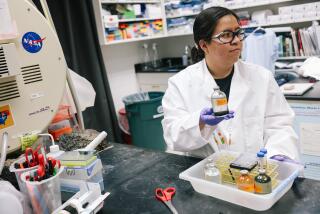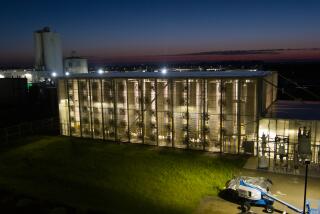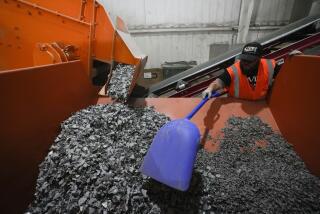Turning sunlight into fuel
“At the California Institute of Technology, they’re developing a way to turn sunlight and water into fuel for our cars,” President Obama said in his Jan. 25 State of the Union address. He was referring to the Joint Center for Artificial Photosynthesis, or JCAP, where a team of California scientists are taking a multi-pronged approach to try to engineer a clean, cheap energy source from the sun.
The project will be led by Caltech’s Nathan Lewis, a chemist. Caltech physicist Harry Atwater is also part of the newly formed Department of Energy-funded project. The Times recently spoke with them about their work on the joint effort.
It’s exciting that the president is talking about innovation happening in California.
Atwater: We were absolutely excited as well. My 13-year-old son, an aspiring chemist, was in the other room watching it on TV; when the president mentioned Caltech, he shouted out: “Dad, is that you?” And I said: “Yeah!”
What we’re working on is turning sunlight into electricity. Solar fuels represents a whole new dimension of research. We want to take the knowledge we have about electronic materials and apply it to a liquid solution to create the precursor to chemical fuel.
How did JCAP get started?
Lewis: There was a national competition to form a Department of Energy hub; 20 consortia applied as teams. The team led by myself, with my colleagues at Caltech, some of the UCs, Stanford, the SLAC National Accelerator Laboratory and the Lawrence Berkeley National Laboratory, won that competition.
We have a California-based team of 200 scientists working on nothing else but fuels from sunlight.
What is artificial photosynthesis?
Lewis: The sun has this little problem — it goes out locally every single night. We need to find a way to store that solar energy. Chemical fuel is the most dense way we know how to store energy.
We’re inspired by what a plant does. Our strategy is to copy nature’s strategy in photosynthesis.
In the lab, after 30 years of research, we know we can make fuel from the sun, in essence a solar fuel. And we can make it in way that is 10 times more efficient than the fastest-growing plant. So we know this can be done.
But we want it to be cheap, efficient and robust. We can now can give you two of those, but not all three at the same time. The goal of JCAP is to get all three.
How soon will we see products or examples of how this works?
Lewis: That is one of the goals — we are going to build prototypes of solar fuel generators as soon as we can. You will be able to hold it in your hand. It will look like bubble wrap, or it might look like a membrane, similar to the material in a very good waterproof jacket.
We are almost positive that the first prototype will not work. The second prototype will probably not work. But sometime, maybe by the sixth time, it will work. In the first five years, we’ll have working prototypes, but the first ones will be expensive. We’ll declare partial victory, but we can always invent ways to make them faster and cheaper.
Can you explain a bit of the chemistry in the photosynthesis you are trying to create?
Lewis: We capture the energy from sunlight in tiny fibers, arranged like fibers on a carpet or blades of grass on a lawn, that are made from the same (but more expensive) materials that are used in solar panels. But instead of making electricity, the sunlight absorbed by these cheap, tiny fibers is directed to catalysts that produce fuel.
One catalyst reacts with water to make oxygen, which we vent into the air. The other catalyst reacts with water to make hydrogen and/or reacts with carbon dioxide from the air, just like a plant does, to make a fuel. This fuel will likely first be hydrogen, but in later implementations we think it could be natural gas or methanol or even possibly gasoline.
We already have many of the needed pieces: We have some of the light-absorbing microfibers; we have some catalysts; we have even connected some of the catalysts together onto the microfibers. But we don’t yet have the whole system all working together, at one time, under the same conditions. Doing that, and doing it in an affordable, scalable way, is the challenge.
What types of materials are involved?
Atwater: Though we will start with known light-absorbing and catalytic materials, we will likely need to invent new materials because the materials we have now don’t have the ideal properties. Eventually, we will have a data library about properties of new semiconductors to draw from. Then we’ll test which of those materials is the most efficient for solar fuel generation.
One of the catalyst materials you’d want to replace is platinum. Why?
Atwater: The thing that platinum does well is to split water in environments that include oxygen and hydrogen. It is stable in both environments and has a high rate of catalysis. We need an Earth-abundant material to replace it because it is rare, and thus expensive.
Can you explain a bit how artificial photosynthesis would work?
Atwater: Artificial photosynthesis is a fantastic scientific problem because it is so multidisciplinary. It involves physics, chemistry and engineering. The physics and chemistry literally meet each other at the interfaces between the light-absorbing and catalyst materials in a solar fuel cell.
The light-absorber materials are semiconductors that absorb sunlight and turn the light into charge carriers, like they do in conventional solar photovoltaic cells. However, rather than generate electricity, in a solar fuel cell the charge carriers are used to catalyze fuel generation at the solid-liquid interfaces. The fuel generation process can be speeded up by the presence of catalysts at the interfaces, so the catalysts are linked to the light absorbers.
Also, in a water-splitting fuel cell, we will generate both hydrogen and oxygen. We need to separate the hydrogen and oxygen because, if we don’t, they will recombine and we’ll have to split the water all over again. That is why we also need membrane materials that can selectively filter and separate the hydrogen and oxygen after they are generated to make sure we can extract the hydrogen and oxygen from the solar fuel cell and make efficient use of them.
This interview was edited for space and clarity from a longer discussion.






